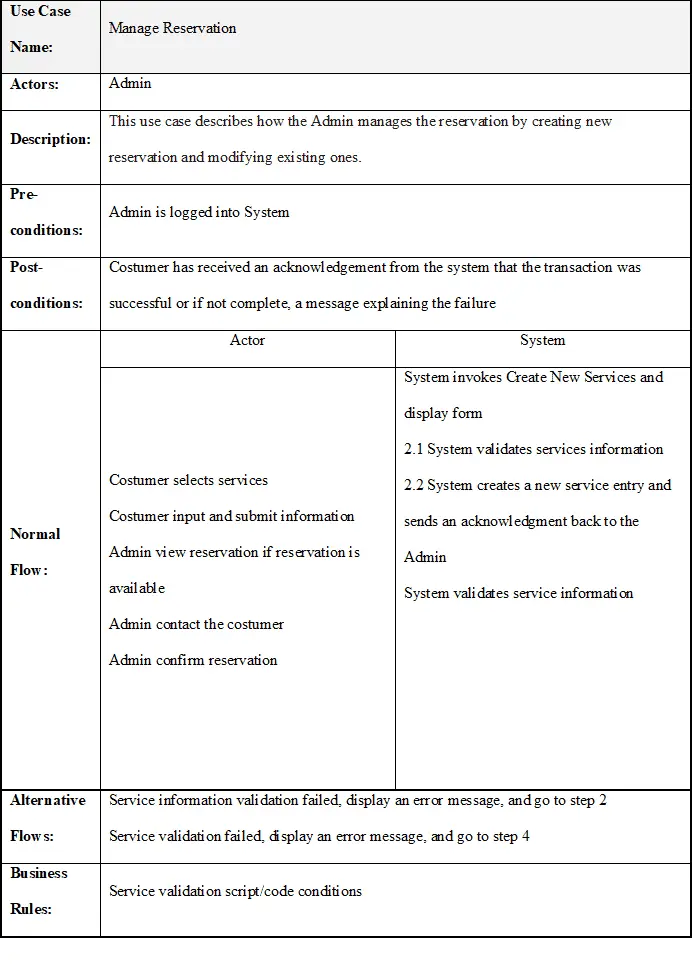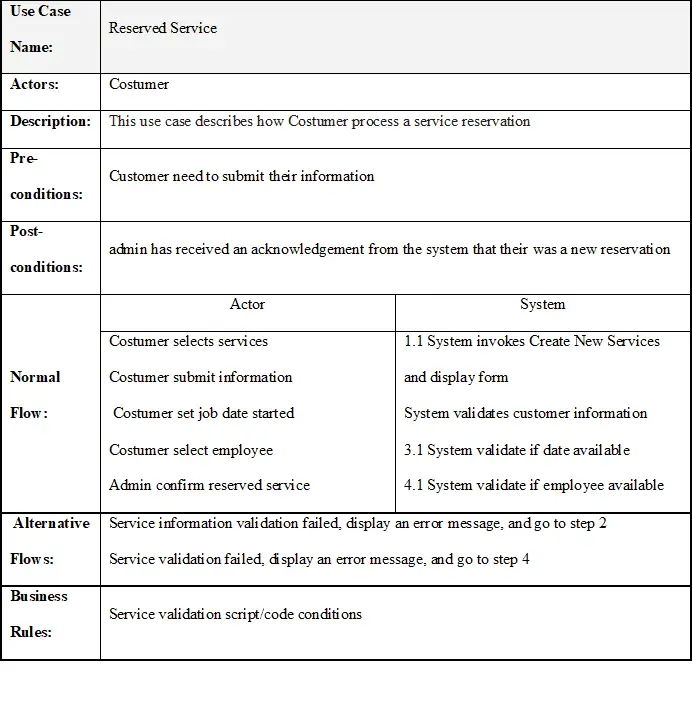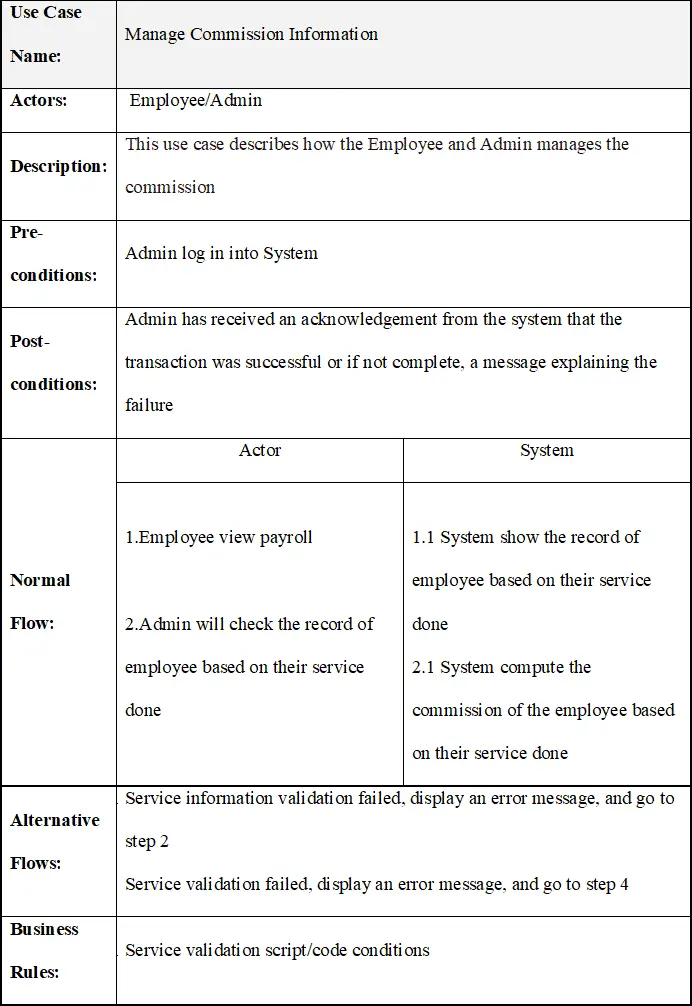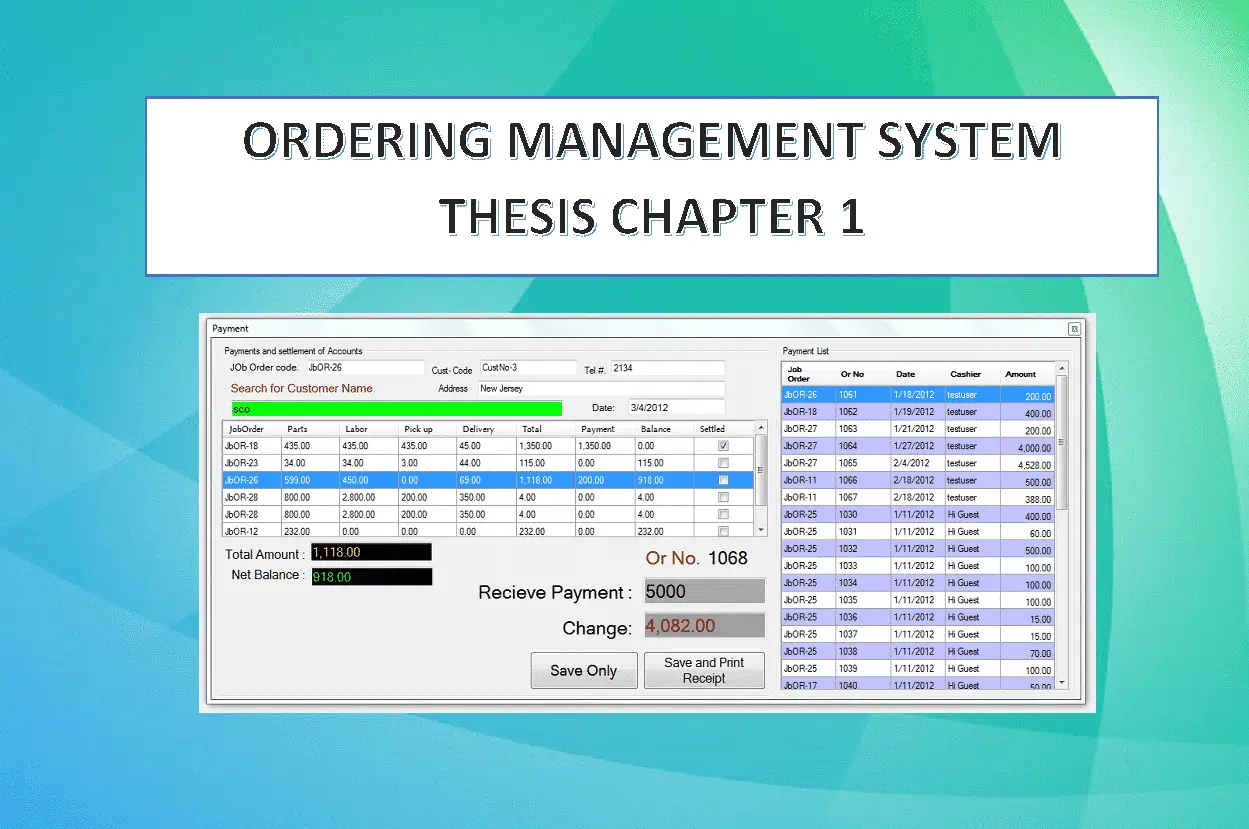Order Management System Thesis Chapter 3 | Methodology
In this article of Order Management System Thesis Chapter 3 | Methodology, the method and software program development tool used to expand the Order Management System might be discussed.
The method used to expand the software might be defined in details collectively with figures and flow charts.
Here’s the Outline of Order Management System Thesis Chapter 3 | Methodology
- Methodology
- System Development Life Cycle(SDLC)
- Cordora Trading and Services System Use Case Model
- Activity Diagram
- Context Diagram
- Dataflow Diagram
- Entity Relationship Diagram
- Data Dictionaries
- Screen Design
- Archetectural Diagram
- Hardware and Software Requirements
- References
Methodology
This chapter presents the system design of the proponent’s system
Order Management System Thesis Chapter 3 | Methodology : System Development Life Cycle(SDLC)
The Software Development Life Cycle (SDLC) is a framework defining tasks performed at each step in the software development process. It is a structure followed by a development team with in the software organization.
It consists of a detailed plan describing how to develop, maintain and replace the specific software. The life cycle defines the methodology for improving the quality of the software and over all development process.
The proponents will use the Rational Unified Process Methodology as a guide of processing the system flow.
Order Management System Thesis Chapter 3 | Methodology : Extreme Programming Methodology

Figure 1: Shows the Extreme Programming Diagram used by the proponents as their model for the system. It shows how the research and process is being implemented from the start of the process until it has been finished.
Extreme programming (XP) is a software development methodology which is intended to improve software quality and responsiveness to changing customer requirements.
As a type of agile software development, it advocates frequent “releases” in short development cycles, which is intended to improve productivity and introduce checkpoints at which new customer requirements can be adopted.
Other elements of extreme programming include: programming in pairs or doing extensive code review, unit testing of all code, avoiding programming of features until they are actually needed, a flat management structure, code simplicity and clarity, expecting changes in the customer’s requirements as time passes and the problem is better understood, and frequent communication with the customer and among programmers.
Release Plan
In this phase, the proponents meet and creates a release plan, which lays out the overall project of CORDORA TRADING AND SERVICES MANAGEMENT SYSTEM. Then used to create iteration plans for each individual iteration.
Iteration Plan
The proponents will meet at the beginning of each iteration to produce that iteration’s plan of programming tasks. Each iteration is 1 to 3 weeks long.
User stories are chosen for this iteration by the customer from the release plan in order of the most valuable to the customer first.
Acceptance Test
The proponents meet with the customer, and the customer specifies scenarios to test when a user story has been correctly implemented.
A story can have one or many acceptance tests, whatever it takes to ensure the functionality works.
Stand Up Meeting
The proponents meet, most of proponents do not contribute, but attend just to hear the outcome of every works, and what problems are causing delays.
Unit Test
The Proponents first create or download a unit test framework to be able to create automated unit tests suites. Second Proponents should test all classes in the system.
Trivial getter and setter methods are usually omitted. Proponents will also create their test first, before the code.
Pair Programming
The proponents select two skilled people in programming, this two programmers work side-by-side at one computer, continuously collaborating on the same design, algorithm, code, or test.
Order Management System Thesis Chapter 3 | Methodology : Cordora Trading and Services System Use Case Model
Describing the process of how the admin manage the reservation of the customer and equipment that needed for the service.
Admin will track the salary of employees based on their service done. To ensure that the salary of employees pay in proper amount.

Manage Reservation
This figure show how the admin manage the reservation

Table 2. Manage Reservation Use Case Description

Order Management System Thesis Chapter 3 | Methodology : Reserve Service
This figure show how the customer reserve the service

Table 3. Manage Reserved Service Use Case Description

Manage Equipment
This figure show how the admin manage the Equipment

Table 4. Manage Equipment Use Case Description

Order Management System Thesis Chapter 3 | Methodology : Manage Commission
This figure show how the admin manage the commission of employee

Table 5. Manage Commission Use Case Description

Order Management System Thesis Chapter 3 | Methodology : Activity Diagram
Reservation

Order Management System Thesis Chapter 3 | Methodology : Employee Deployment

Order Management System Thesis Chapter 3 | Methodology : Context Diagram
The context diagram of Cordora Trading and Services Management System represented below shows the flow of the system throughout the system process.
It show what information could be input, where the data goes and how it is stored.

Order Management System Thesis Chapter 3 | Methodology : Dataflow Diagram
Data flow diagram of proposed solution all the concept and flows of each entity that shows all the process in proposed identity which the process begins.





Order Management System Thesis Chapter 3 | Methodology : Entity Relationship Diagram

Order Management System Thesis Chapter 3 | Methodology : Data Dictionaries
These tables below provide the entire database tables details such as Field Name, Descriptions, data types, character lengths.
Table 6: TABLE AUTONUM
| Field Name | Description | Type | Length |
| ID(PK) | id | Int | 11 |
| START | start | Varchar | 250 |
| END | end | Int | 11 |
| INCREMENT | increment | Int | 11 |
| DESCRIPTION | description | Varchar | 250 |
This table show the attributes of entity of autonum
Table 7: TABLE CATEGORY
| Field Name | Description | Type | Length |
| CAT_ID(PK) | Cat ID | Int | 11 |
| CAT_NAME | Cat Name | Varchar | 50 |
This table show the attributes of entity of category
Table 8: TABLE CUSTOMER
| Field Name | Description | Type | Length |
| CID(PK) | Cid | Int | 11 |
| CUSTOMER_CODE | Customer Code | Varchar | 2 50 |
| CUSTOMER_NAME | Customer Name | Varchar | 250 |
| CUSTOMER_ADDRESS | Customer Address | Varchar | 250 |
| CONTACT_PERSON | Contact Person | Varchar | 250 |
| CUSTOMER_TEL | Customer Tel | Varchar | 250 |
This table show the attributes of entity of customer
Table 9: TABLE EMPLOYEE
| Field Name | Description | Type | Length |
| EMP_ID (PK) | Employee Id | Int | 11 |
| L_NAME | Last Name | Varchar | 250 |
| F_NAME | First Name | Varchar | 250 |
| M_NAME | Middle Name | Varchar | 250 |
| BDAY | Birthday | Varchar | 250 |
| AGE | Age | Varchar | 500 |
| GENDER | Gender | Varchar | 500 |
| CONTACT | Contact No. | Varchar | 500 |
| POSITION | Position | Varchar | 500 |
| DATE_HIRED | Date Hired | Varchar | 500 |
This table show the attributes of entity of employee
Table 10: TABLE EQUIPMENT
| Field Name | Description | Type | Length |
| ID (PK) | Id | Int | 11 |
| CAT_ID (FK) | Cat Id | Varchar | 250 |
| EQUIP_NAME | Equipment Name | Varchar | 250 |
| EQUIP_QTY | Equipment Qty | Int | 11 |
| EQUIP_PRICE | Equipment Price | Int | 11 |
| EQUIP_USE | Equipment Use | Varchar | 250 |
This table show the attributes of entity of equipment
Table 11: TABLE PAYMENTS
| Field Name | Description | Type | Length |
| ID (PK) | Id | Int | 11 |
| JOB_CODE | Job Code | Varchar | 100 |
| ORDER_NO | Order Name | Varchar | 100 |
| STATUS | Status | Varchar | 100 |
| AMOUNT | Amount | Varchar | 100 |
| RECEIVE | Receive | Varchar | 100 |
| CHANGES | Changes | Varchar | 100 |
This table show the attributes of entity of payments
Table 12: TABLE USER
| Field Name | Description | Type | Length |
| USERID(PK) | User Id | Int | 11 |
| USERNAME | User Name | Varchar | 250 |
| USERUSERNAME | User User Name | Varchar | 250 |
| USERPASSWORD | User Password | Varchar | 250 |
| USERTYPE | User Type | Varchar | 250 |
This table show the attributes of entity of user
Table 13: TABLE RESERVATION
| Field Name | Description | Type | Length |
| JID (PK) | Id | Int | 11 |
| JOB_CODE | Job Code | Varchar | 250 |
| CUSTOMER_CODE | Customer Code | Varchar | 250 |
| CUSTOMER_NAME | Customer Name | Varchar | 250 |
| CUSTOMER_ADDRESS | Customer Address | Varchar | 250 |
| CONTACT_PERSON | Contact Person | Varchar | 250 |
| CUSTOMER_TEL | Customer Tel | Varchar | 250 |
| QTY | Qty | Varchar | 250 |
| SERIAL_NO | Serial No | Varchar | 250 |
| DESCRIPTION | Description | Varchar | 250 |
| PROBLEM | Problem | Varchar | 250 |
| ACTION_TAKEN | Action Taken | Varchar | 250 |
| EMP_CHARGE | Employee Incharge | Varchar | 250 |
| TRANSACTION | Transacation | Varchar | 250 |
| DATE | Date | Varchar | 250 |
| TIME | Time | Varchar | 250 |
| LABOR | Labor | Varchar | 250 |
| PARTS | Parts | Varchar | 250 |
| EXPENCES | Expences | Varchar | 250 |
| STATUS | Status | Varchar | 250 |
| TOTAL_AMOUNT | Total Amount | Varchar | 250 |
This table show the attributes of entity of reservation
Table 14: TABLE COMMISSION
| Field Name | Description | Type | Length |
| ID (PK) | Id | Int | 11 |
| EMPLOYEEID | Employee Id | Varchar | 250 |
| CUSTOMER_CODE | Customer Code | Varchar | 250 |
| JOB_CODE | Job Code | Varchar | 30 |
| C_COMMISSION | Commission | Varchar | 30 |
| C_DATE | Date | Varchar | 30 |
| C_TIME | Time | Varchar | 30 |
This table show the attributes of entity of commission
Order Management System Thesis Chapter 3 | Methodology : Archetectural Diagram

Order Management System Thesis Chapter 3 | Methodology : Hardware and Software Requirements
In the development of the system, the developer uses both software and hardware are recommended.
The following Hardware and Software specifications should be considered for the development of the system project.
Order Management System Thesis Chapter 3 | Methodology : Development:
Computer Unit Specification
Processor: intel CORE i3 7th Gen
RAM: 4GB
ROM: 1TB
Others: Printer and USB cord
Software Development Specification
VB.Net 2008
MYSOL
References
Reservation System of Boracay Grand Vista Resort and Spa (2011). Retrieved from google:
www.academia.edu/23715001/CHAPTER_2_REVIEW_OF_RELATED_LITERATURE_AND_STUDIES_Online_Billing_and_Reservation_System (December 11, 2019 11:27)
Online Sales and Inventory System of ACME Tacloban Hardware 2013). Retrieved from google: capstoneguide.com/lesson/review-of-related-literature-sales-inventory-system-barcode (December 11, 2019 11:31)
Payroll Management of Krizalen Enterprises (2014). Retrieved from google: www.slideshare.net/SavioAberneithie/payroll-management-system-complete-report
(December 11, 2019 11:35)
Job Order Cost System (2014). Retrieved from google:
www.cliffsnotes.com/study-guides/accounting/accounting-principles-ii/traditional-cost-systems/job-order-cost-system (December 11, 2019 11:40)
Sales & Inventory Monitoring Systems of A&A International Industries Inc (2013). Retrieved from google: www.academia.edu/28938437/CHAPTER_2_Review_of_Related_Literature_and_Studies (December 11, 2019 11:43)
Payroll Management of ABN Amro Holding N.V (2012). Retrieved from google:
www.scribd.com/doc/250214407/chapter2-payroll-system (December 11, 2019 11:49)
Online Billing and Reservation System for Royal Palm Paradise Resort (2013) Retrieved from google: www.academia.edu/23715001/CHAPTER_2_REVIEW_OF_RELATED_LITERATURE_AND_STUDIES_Online_Billing_and_Reservation_System?auto=download
(December 11, 2019 11:55)
Computerized Sales and Inventory System for Anthony’s General Merchandise and Construction Supply(2013). Retrieved from google: www.bartleby.com/essay/Computerized-Sales-and-Inventory-System-for-Anthonys-FK9V8CE36ZYS (December 11, 2019 11:58)
Payroll System & Taxation of Accord Networks Ltd(2014). Retrieved from google:
www.coursehero.com/file/29324569/Chapter-IIdocx (December 11, 2019 12:03)
Online Billing and Reservation System of Bug Hotel. Retrieved from google:
www.academia.edu/23715001/CHAPTER_2_REVIEW_OF_RELATED_LITERATURE_AND_STUDIES_Online_Billing_and_Reservation_System (December 11, 2019 12:07)
CISS (Computer Inventory System Specialists Ltd.) Purchase Order Management (2013). Retrieved from google: www.academia.edu/28938437/CHAPTER_2_Review_of_Related_Literature_and_Studies (December 11, 2019 12:11)
Payroll Management System of Trendstatic Corporation (2010). Retrieved from google: www.academia.edu/31818773/WEB_BASED_PAYROLL_SYSTEM_LAS_PINAS_CITY_HALL_In_Partial_Fulfillment_Of_the_Requirements_for_the_Degree_Bachelor_of_Science_in_Information_Technology_Members (December 11, 2019 12:16)
Related Article
- Pharmacy Management System Thesis | Chapter 3 – Methodology
- Online Restaurant Management System Documentation Chapter 3
- Sales and Inventory System Documentation Chapter 3
- Library Borrowing System Documentation | Chapter III – Methodology
- Attendance Monitoring System Documentation | Chapter 3
Inquiries
if you have any questions or suggestions about Order Management System Thesis Chapter 3 | Methodology, please let’s me know by dropping your comment below.

